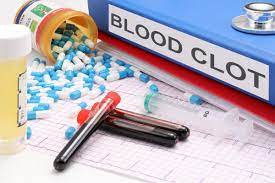برتوتوكول معالجة حالة الCVST أي الخثرات المترافقة مع انخفاض حاد في الصفيحات وهي حالة نادرة جدا ولكن لوحظت مع لقاحات أسترازينيكا بمعدل 9.3 حالة لكل مليون وبمعدل 2 حالة لكل مليون من لقاح جونسون وتم تسمية الخثرات ب VITT (نسبتها أعلى ب 8-10 مرات مع الكوفيد بالمقارنة مع اللقاح)
النساء والشباب بين 18-50 أكثر عرضة للإصابة وعوامل أخرى مثل تناول الأدوية الكيمياوية المضادة للسرطان ومانعات الحمل الفموية
المعالجة تتضمن الأدوية الحالة للخثرات ولكن غير الحاوية على الهيبارين مثل bivalirudin, danaparoid, fondaparinux أو حالات الخثرات ذات التأثير المباشر مثل apixaban, rivaroxaban
تحليل الدم يتضمن التحري عن الأجسام المضادة anti-PF4 ومستوى D-dimer
البروتوكول معتمد من قبل الجمعية الأميركية لأمراض القلب
أيضاً التفصيل في الرابط
- All patients with suspected CVST due to a COVID-19 vaccine should be treated with non-heparin anticoagulants such as argatroban, bivalirudin, danaparoid, fondaparinux or a direct oral anti-coagulant (DOAC). No heparin products in any dose should be given.
- Magnetic Resonance Imaging with a venogram (MRI/MRV) or computed tomography with venogram (CT/CTV) is recommended to accurately detect and diagnose CVST.
- Blood tests should include a CBC (Complete Blood Count) plus:
- platelet count – to determine the number of platelets per liter of blood;
- a peripheral smear – examination under a microscope to count the number of various types of blood cells and if they appear normal;
- a prothrombin time – to measure how long it takes the blood to clot;
- a partial thromboplastin time – a measurement of how long it takes the blood to clot, specifically measuring for these clotting factors: factor VIII, factor IX, factor 1V and factor XII;
- a fibrinogen test – to measure for the presence of fibrin, a protein found in the blood that indicates that blood clotting has been activated;
- a D-dimer test – to measure for the presence of D-dimer, a small protein that’s made when blood clots are dissolving in the body; and
- a PF4 antibody ELISA test – to test for PF4 antibodies, which the body sometimes creates in the blood to fight against the anticoagulant heparin.
- Anticoagulation treatment doses may need to be tailored if platelet counts are extremely low (<20,000/mm3) or if there is low fibrinogen.
- Anticoagulants should be used to treat CVST even if there is a secondary hemorrhage in the brain in order to prevent progressive thrombosis and to control bleeding.
- Platelet transfusion should be avoided.
- Once platelet counts return to normal (150,000 to 450,000/mm3), most patients can be transitioned to an oral anticoagulant if there are no contraindications.
- The authors note that based on their evaluation of the American Society of Hematology’s recommendations and two recently published studies, individual patient factors should be considered regarding the use of a direct oral anticoagulant (DOAC) or a vitamin K agonist (VKA) after there is full platelet count recovery.
American Heart Association

